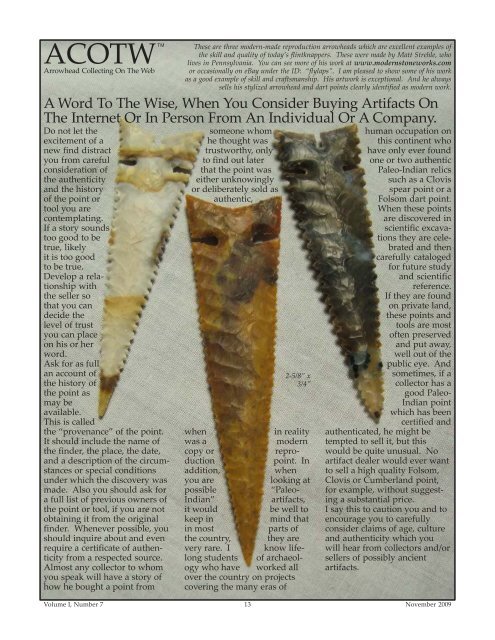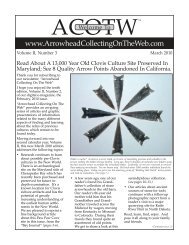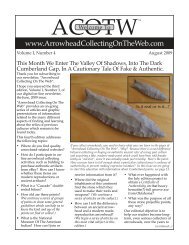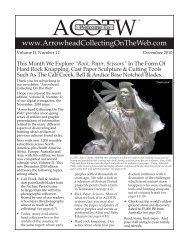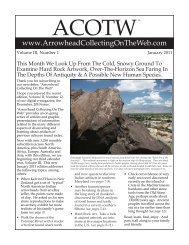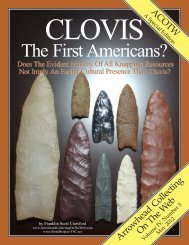STOP! - Arrowhead Collecting On The Web
STOP! - Arrowhead Collecting On The Web
STOP! - Arrowhead Collecting On The Web
You also want an ePaper? Increase the reach of your titles
YUMPU automatically turns print PDFs into web optimized ePapers that Google loves.
ACOTW<br />
<strong>Arrowhead</strong> <strong>Collecting</strong> <strong>On</strong> <strong>The</strong> <strong>Web</strong><br />
TM <strong>The</strong>se are three modern-made reproduction arrowheads which are excellent examples of<br />
the skill and quality of today’s flintknappers. <strong>The</strong>se were made by Matt Strehle, who<br />
lives in Pennsylvania. You can see more of his work at www.modernstoneworks.com<br />
<strong>Arrowhead</strong> <strong>Collecting</strong> <strong>On</strong> <strong>The</strong> <strong>Web</strong> or occasionally on eBay under the ID: “flylaps”. I am pleased to show some of his work<br />
as a good example of skill and craftsmanship. His artwork is exceptional. And he always<br />
sells his stylized arrowhead and dart points clearly identified as modern work.<br />
A Word To <strong>The</strong> Wise, When You Consider Buying Artifacts <strong>On</strong><br />
<strong>The</strong> Internet Or In Person From An Individual Or A Company.<br />
Do not let the<br />
excitement of a<br />
new find distract<br />
you from careful<br />
consideration of<br />
the authenticity<br />
and the history<br />
of the point or<br />
tool you are<br />
contemplating.<br />
If a story sounds<br />
too good to be<br />
true, likely<br />
it is too good<br />
to be true.<br />
Develop a relationship<br />
with<br />
the seller so<br />
that you can<br />
decide the<br />
level of trust<br />
you can place<br />
on his or her<br />
word.<br />
Ask for as full<br />
an account of<br />
the history of<br />
the point as<br />
may be<br />
available.<br />
This is called<br />
the “provenance” of the point.<br />
It should include the name of<br />
the finder, the place, the date,<br />
and a description of the circumstances<br />
or special conditions<br />
under which the discovery was<br />
made. Also you should ask for<br />
a full list of previous owners of<br />
the point or tool, if you are not<br />
obtaining it from the original<br />
finder. Whenever possible, you<br />
should inquire about and even<br />
require a certificate of authenticity<br />
from a respected source.<br />
Almost any collector to whom<br />
you speak will have a story of<br />
how he bought a point from<br />
someone whom<br />
he thought was<br />
trustworthy, only<br />
to find out later<br />
that the point was<br />
either unknowingly<br />
or deliberately sold as<br />
authentic,<br />
2-5/8” x<br />
3/4”<br />
when in reality<br />
was a modern<br />
copy or reproduction<br />
point. In<br />
addition, when<br />
you are looking at<br />
possible “Paleo-<br />
Indian” artifacts,<br />
it would be well to<br />
keep in mind that<br />
in most parts of<br />
the country, they are<br />
very rare. I know lifelong<br />
students of archaeology<br />
who have worked all<br />
over the country on projects<br />
covering the many eras of<br />
human occupation on<br />
this continent who<br />
have only ever found<br />
one or two authentic<br />
Paleo-Indian relics<br />
such as a Clovis<br />
spear point or a<br />
Folsom dart point.<br />
When these points<br />
are discovered in<br />
scientific excavations<br />
they are celebrated<br />
and then<br />
carefully cataloged<br />
for future study<br />
and scientific<br />
reference.<br />
If they are found<br />
on private land,<br />
these points and<br />
tools are most<br />
often preserved<br />
and put away,<br />
well out of the<br />
public eye. And<br />
sometimes, if a<br />
collector has a<br />
good Paleo-<br />
Indian point<br />
which has been<br />
certified and<br />
authenticated, he might be<br />
tempted to sell it, but this<br />
would be quite unusual. No<br />
artifact dealer would ever want<br />
to sell a high quality Folsom,<br />
Clovis or Cumberland point,<br />
for example, without suggesting<br />
a substantial price.<br />
I say this to caution you and to<br />
encourage you to carefully<br />
consider claims of age, culture<br />
and authenticity which you<br />
will hear from collectors and/or<br />
sellers of possibly ancient<br />
artifacts.<br />
Volume I, Number 7 13<br />
November 2009


